Yashica 35mm Rangefinder Chronology & Specifications II
Featured are the Lynx 14, 5000, 1000 models, Yashica J, Campus, Ministers models III, D, 700,
Yashica EE, GX, EL, Minimatic S and C versions, M5 & FC.
Page Updated October 24, 2013
Your first reaction to seeing a Lynx might well be "Wow! .... Yashica has made a 127 roll film rangefinder".
Of course you would be wrong.... This massive camera is quite distinct from it's kin and stands considerably taller. It weighs in at fully 8 ounces more than the Minister D, which matches all it's capabilities except for the maximum lens opening. The actual weight of the Lynx 14e without case, strap, film and batteries not included, tips the scale just 1 ounce short of 2 lbs.
The weight is of course a reflection of the "Monster" ƒ1.4 lens, comprising 7 Optical Elements in 5 Groups!
It takes a 60mm slip-on lens cap or 58mm screw in filters and adapters. Glass this large cries out for a lens shade, and one is mandatory to take the definition of the lens to the max. This baby has a face that only a mother could love, yet despite this, the Lynx above all other Yashicas has an ardant following of enthusiasts bordering on a cult. 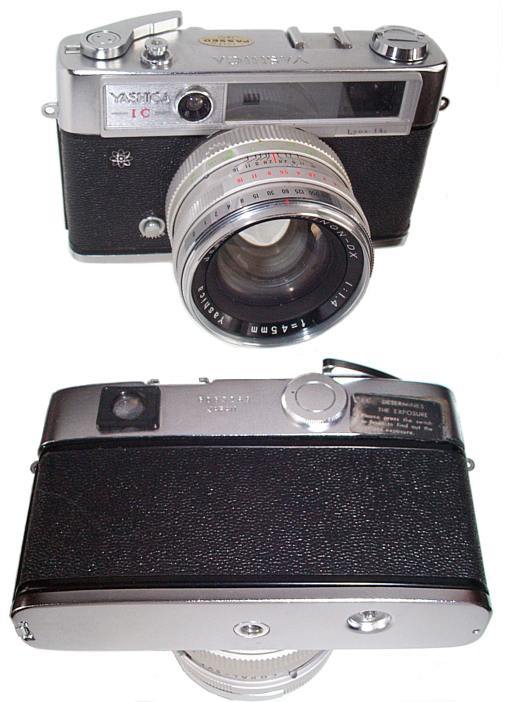 Perhaps it can be explained by the replacement of the earlier ƒ1.8 optic with a superb Yashinon DX ƒ1.4 45mm lens which stops down to ƒ16. introduced with the Model 14. Never again need the user call on grainy films above 100 ASA, under any imaginable conditions. Could it be due to the fact that the shutter speed is at the command of the photographer?
Perhaps it can be explained by the replacement of the earlier ƒ1.8 optic with a superb Yashinon DX ƒ1.4 45mm lens which stops down to ƒ16. introduced with the Model 14. Never again need the user call on grainy films above 100 ASA, under any imaginable conditions. Could it be due to the fact that the shutter speed is at the command of the photographer?
Perhaps the explanation is that in 1966 the Lynx 5000 was the first camera ever to incorporate Integrated Circuit technology, another major Yashica innovation.
The 14e depicted here still proudly sports the IC designation. It shares the automatic parallax correcting viewfinder of the G series, as well as their "Magic Spot" rangefinder. The Copal SVE shutter can can be set to "B" [bulb], 1, 2, 4, 8, 15, 30, 60, 125, 250 and 500th second. Flash synch can be set at X or M delay, and at X [Strobe] will synch at any speed, very useful for outdoor fill light a feature lacking in SLR's. A PC socket for a flash cable is located at the right side near the top. Note that the camera does not have a hot shoe. In order to use a strobe with a hot contact, be sure to cover the shoe with a piece of insulation tape or the flash will fail to charge and just run down the batteries or if previously charged will fire when it comes in contact with the camera. ASA can be selected from 10 through 800, by pressing in and shifting a lever across the ƒ stop settings. The rear view shows the location of the battery port and cap located below the film advance lever, as well as the tab on the extreme bottom left , which is the door lock release as featured on the original Electro 35. The sprocket release button is toward the right of the tripod mount. Failure to depress the rewind release button when winding the film back into the film cassette can result in torn film sprockets and very likely serious damage to the camera's transport mechanism. A sticker on the back reminds the user to press the "Switch" on the lower front left, to turn on the exposure meter, even though that push button on the front is clearly marked "Switch" in the 14e. The light sensor itself is clearly visible to the left of and directly in line with the viewfinder. The poor choice of location so close to the lens is almost certain to create problems unless the lens hood is folded back or removed while metering. Flare off the alloy lens barrel may also cause problems.
For those concerned with battery availability required for the Over / Under text Exposure display in the finder, replacement batteries are still available most anywhere only for the original version using the PX625A.
The factory specified batteries used by the Lynx are shown below:
Lynx 14 1 - PX625A Lynx 5000 1 - PX625ALynx 14e 2 - PX640A Lynx 5000e 2 - PX640A
Since the batteries only run the exposure meter, you could conveniently forget about them altogether, if you have a separate exposure meter. Just a note in passing, the peel off labels of the Japan Camera Institute compliance and the Exposure Switch reminder are firmly in place on the camera shown, but the Lynx 14e name-plate cement failed and the plate fell off at some point and was never recovered. The Internal DIN / ASA converter Chart similarly fell off and was saved only because it was trapped in the camera. Too bad they didn't use the same glue as the peel-off labels. You may want to inspect yours now. The Lynx 14e designation which was "dropped" into the image is a reasonable facsimile of the original.
The model 5000 and 14 [ seen further down below ] were produced and sold side by side as were the later 'E' versions. The choice was in the maximum lens aperture. The model 14 commanded a mere $15 premium. The 'E' version was an upgrade from a single battery to dual batteries needed to power a somewhat more reliable light sensor requiring a higher voltage.
The Yashica Lynx 1000 was the aptly named first of the series. Keen eyed, sleek, ready to spring into action and able to capture it's prey in a mind boggling 1/1000 th of a second. It was introduced in 1960.
It is illustrated here in a series of © images made available thanks to Kevin E Rafferty.

The astonishing performance is made possible by a Copal SV shutter in an assembly which incorporates a coated and colour corrected Yashinon 6 element lens in 4 groups, which is similar to the 5000 model. The 45mm lens has a maximum aperture of ƒ1.8, & and is threaded to accept a 46mm filter.
Most welcome is the ability to stop down to ƒ22, a feature lacking in most other modern 35mm camera lenses.
The shutter affords a speed range from "Bulb" for time exposures through 1 2 4 8 15 30 60 125 250 500 and an awesome 1/1000 th of a second!
A self timer with a nominal delay of 8 seconds, is also provided. Flash synch can be set at X or M. Strobe flash will fire at any shutter speed setting at X synch. The shutter release is threaded to accept a cable or remote control release.
While many SLRs can match the shutter speed of this Lynx, the traveling curtain shutter of those cameras results in a fast moving object appearing 'stretched'. Not so, with the between the lens shutter of the Lynx.
The ASA speed is adjusted by moving a lever on the lens barrel which indicates the selected speed in a window on the opposite side of the lens housing.
The ASA range direct steps are: 10 16 32 50 100 200 400 800. While many of the popular film emulsions of those speeds are no longer on the market, things have a habit of coming full circle.
The bright viewfinder has the same automatic parallax correcting frame line adopted by the later G series, as well as the "Magic Spot" split image rangefinder that performs well under even the lowest light levels.
The camera needs to be handled with care [as any camera should be anyway] due to the light meter which has a moving needle indicator [galvanometer] as found in many popular exposure meters. The added camera care will reward you with a direct photo / electric driven exposure meter that makes the user independent of any battery requirement what-so-ever.
The use of the Yashica rubber lens shade in all these images of the 1000 brings home the fact that the light sensor is able to function without interference and the viewfinder has only the smallest lower right section clipped. You really can't get away with this in the 14e in my opinion.
The flash shoe is not hot. In order to mount a Strobe which has contacts on the base for a hot shoe, the base of the shoe needs to be insulated with a thin piece of stiff plastic or insulation tape. Be sure to drape the cable from the strobe gun to the PC socket on the left side of the front of the camera, so that it does not go over the fresnel lens light sensor. The side mounted PC socket of the later Yashica Rangefinders solved this long overlooked problem.
An extremely useful feature dropped in subsequent Yashicas, is a small barely noticeable stubby lever on the focusing ring, that greatly simplifies bringing the split image finder into sharp focus pronto, without fingers blocking the viewfinder or light sensor. The last image in the series clearly shows this feature.
To the left on this last image, a circular recess is visible. This houses a small lever and the designation O - P with an arrow pointing past the "O". To release the back door of the camera for loading, the lever needs to be pressed in and moved toward the "O" position. The cartridge is loaded in the standard way by retracting the main wind knob. The rewind lever is folded within this knob and is easily lifted up, either operation being unlike the finger-nail breaking exercise encountered with the Canonette QL17/19. On the opposite side of the base, a recess shields the sprocket release button. Before rewinding film back into the cartridge, this button must be pressed to the "in" position. Failure to do so, can and most likely will, damage the brass gears and mechanism of the camera.
In 1962 the Lynx 5000 replaced the earlier model with some drastic changes. The light energised Photo Electric cell was replaced with a battery powered Cds sensor that provides accurate read-outs at lower light levels. The overall size of the 5000 is precisely the same as the prior 1000, or the later 'E' for that matter, with the base of the camera being 13 cm [5 1/16 inch]. The bottom plate is identical with the exception of a battery cap that retains one PX625 alkaline battery.
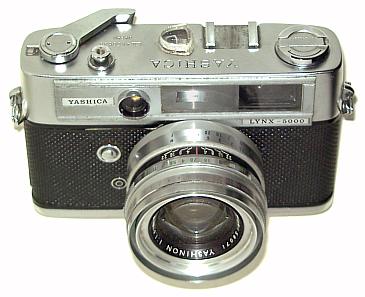
Correct exposure is determined by centering the needle on the top plate. The ASA / ISO film speed is set through a window on the lens assembly. The Copal SV shutter has a top speed of 1000/th sec, with a total range of 11 speeds stepping though 1/1000, 1/500, 1/250, 1/125, 1/60, 1/30, 1.15, 1/8, 1/4, 1/2. 1 sec and 'B'. A self timer and selectable X M sync, round out the features. There is no 'hot shoe'. The PC socket for a flash cable, is located on the front of the body.
The Yashinon 6 element lens has aperture ranges from ƒ1.8 to ƒ22, a nice feature if you want to take depth of focus to the max. Focus range is from .8 Meters [2.6 ft] to infinity. It accepts 46mm screw-in filters or a 54mm push on folding rubber lens hood.
The bright viewfinder frame line adjusts to compensate for parallax as the focus ring is moved. A centre split image rangefinder works well under the lowest light conditions if you can find a contrasty object to focus on. This is the same winning system carried over to the Electro series. The Lynx 5000e that followed this model is basically similar in size and function, but introduces an Over / Under display in the finder. I can't say whether this reads in English in all these cameras, but I have never found one that does not. This readout display required the battery power to be upgraded to two PX 640 batteries, which are expensive and in the long term have a nasty tendency to leak, so be sure to remove them when the camera is not in use.
The year 1961 saw the emergence of the Yashica J.
When one arrived at my house some 40 years later it caused quite a stir!
At last.....a Custom Built Personalized Yashica, just for me with an impressive "in your face" monogram, that no one could ignore. So if your name happens to be Jane, Joe, Judy or James, you just 'gotta' have one of these.
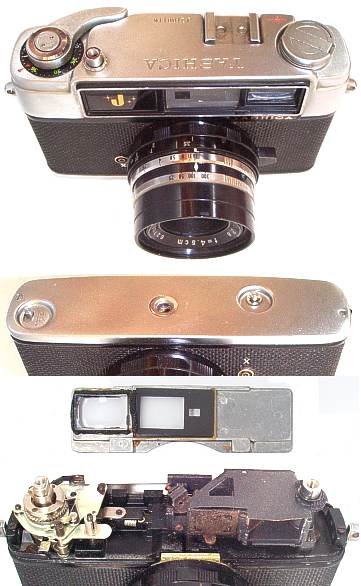 If not... well you might just ponder on why they brought this model to the market place. My take is that they had a great many left over parts from various models and integrated them into an endless alphabet soup of price killer models. Careful observation shows that it's not quite in the Lynx 1000 league
If not... well you might just ponder on why they brought this model to the market place. My take is that they had a great many left over parts from various models and integrated them into an endless alphabet soup of price killer models. Careful observation shows that it's not quite in the Lynx 1000 league
It combines the Lynx body and bottom plate, but the place where an exposure system would go is blank. Hence the billboard size J Logo. On the reverse side of the top plate a cover screw provides access to the range-finder's split image vertical adjustment screw.
The modest Copal Shutter and lens assembly are from the YK era inventory. The Yashinon 45mm ƒ2.8, lens has 4 Optical Elements in 3 groups, and is mated to a shutter with a top speed of 1/300th, with added settings at 1/100, 1/50, 1/25 and Bulb. Flash synch is X for strobe guns at any shutter speed setting.
As the top view with the cover removed reveals, the frame line is fixed. This may be due to the fact that the closest focus distance is 1 meter, which is easily compensated for by the dual frame line visible in the finder. To reset the frame counter, the dial is turned gently in a counter-clockwise position with the tip of a finger.
The stripped down view shows the frame counter ratchet arrangement which has 2 pawls [fingers] engaging the gear. The mask which provides the superimposed frame line in the finder can also be seen. It appears to be stamped out of brass.
The reverse side of the front bezel is shown. Unlike later Yashicas, this holds the front lens element of the finder. Glass only protects the Rangefinder elements. Visible too, are wooden shims which hold the bezel in the correct alignment to the body depending on minor variations in the castings. Does this make the camera susceptible to termite attack ? That's not as far out as you may think, because when I took this camera apart, I found a mummified mealie worm of some sort next to the finder.
The Yashica Campus is essentially the Model "J" body with a lens and shutter upgrade. Introduced in Japan in 1962, few are found on the internet auction market. Our thanks to Richard Squires of New Zealand for providing the image and details. The camera shown has the Kaligar Wide / Tele viewfinder mounted in the flash shoe. These Kaligar accessory lenses screwed into the front of the non
removable prime Yashinon Lens.
The camera shown has the Kaligar Wide / Tele viewfinder mounted in the flash shoe. These Kaligar accessory lenses screwed into the front of the non
removable prime Yashinon Lens.
It is not clear if these Wide / Tele Adapters are suitable for use with camera models having the same focal length and 46mm screw- in thread, as found in several earlier Yashicas. Certainly worth a shot though.
The camera has a really cool retro look but the same limitations as the "J" in that it has no exposure meter and the frame line does not move to compensate for parallax. The Yashinon 45mm Lens has a Maximum Aperture of ƒ2.8 and stops down to a very useful ƒ22.
The COPAL-SV Shutter is clearly marked SV in red. Available shutter speed settings are 500, 250, 125, 60, 30, 15, 8, 4, 2, 1, B. It features both X and M flash sync modes and a self timer.
The introduction of the Minister III is recorded as 1963. This design moved the sensor for the photo electric cell from the usual upper left position found in many cameras, to a cluster mounted within the lens assembly. 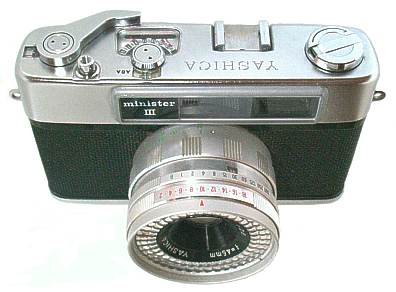 This
Cyclops design would take into account any lens filters, and prevented a lens shade from stopping any part of the light from reaching the exposure metering system. The true photo-electric cell requires no batteries, and the meter reading of the camera displayed here, still matches a Sekonic reference meter to this day.
This
Cyclops design would take into account any lens filters, and prevented a lens shade from stopping any part of the light from reaching the exposure metering system. The true photo-electric cell requires no batteries, and the meter reading of the camera displayed here, still matches a Sekonic reference meter to this day.
The Citizen shutter assembly houses a Yashinon lens with 5 Optical Elements in 4 Groups with a maximum aperture of ƒ2.8 lens and a 45mm focal length. Speeds range from 'B' 1 2 4 8 15 30 60 125 250 1/500th secs. Strobe synch is good at any speed. M synch is at 1/15th sec. The shutter release button accepts a standard threaded cable. The self timer lever is located at the bottom of the lens barrel.
ASA speed control for the meter is from 10 to 400, still wide enough to be useful today for 99.9% of any images that it may be called upon to capture.
The exposure meter needle on the top plate of the camera points to a number from 2 to 18. When the outer lens ring with a matching number set is lined up with the indicated number, the correct exposure selected can be viewed through a small port on the lens barrel. The ƒ stop varies as the shutter speed selection ring is turned. This is about as idiot proof a system as anyone could design, and still provide full manual control. The camera rear door opening mechanism matches the prior Lynx 1000 and the following Minister D.
The bug eyed Yashica "Minister" III morphed into the Minister [IV] Model D in 1964 [ as near as we can tell ]. As hard as we look, we can't find anything that's not to like on this camera. It may be the perfect choice for a photo / journalism student because the price is right and it comes "loaded".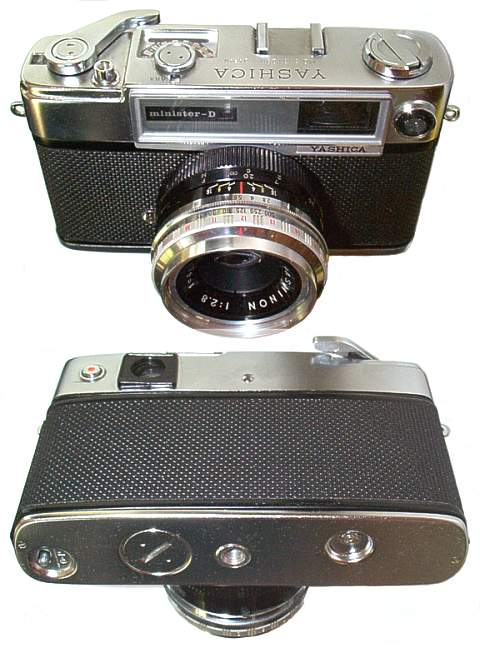 The dependable Yashica film transport serves to support the strictly mechanical Copal SVL shutter. The Yashinon 45mm ƒ2.8 lens has an angle of view of 56º. Yes, there are faster Yashinons out there, but the fact is that film emulsion speeds have increased to such a degree while the grain structure has actually been reduced since the introduction of these cameras, that ASA 100 film with the ƒ2.8 lens, may be all that you will ever need. The lens mount accepts 46mm screw-in accessories.
The dependable Yashica film transport serves to support the strictly mechanical Copal SVL shutter. The Yashinon 45mm ƒ2.8 lens has an angle of view of 56º. Yes, there are faster Yashinons out there, but the fact is that film emulsion speeds have increased to such a degree while the grain structure has actually been reduced since the introduction of these cameras, that ASA 100 film with the ƒ2.8 lens, may be all that you will ever need. The lens mount accepts 46mm screw-in accessories.
Let's leave the editorializing behind and see what make this camera tick.
User selectable shutter speeds are: B, 1, 2, 3, 4, 8, 15, 30, 60, 125, 250, 500. secs. The shutter can be set at M or X synch. One oddity is that the shutter must be set at X synch to use the self timer, regardless of whether you are using flash or not. A self timer with a nominal 8 sec delay is provided. The shutter button is threaded to accept a cable release. Electronic flash fires and synchs at any speed, great for exterior fill light.The user selectable aperture ranges from ƒ16 to 2.8. Moving the aperture ring, changes the selected ƒ stop in step with the shutter speed dial.
To move only the ƒ stop, an extreme outer ring is provided. Changing the shutter speed is therefore a two step procedure. First move the Aperture and the Speed in tandem to the desired speed, then move the Aperture only to alter it's desired setting, using the outer ring. This might seem like a pain, but most of the time really speeds up any change you wish to make once the initial correct exposure has been determined.
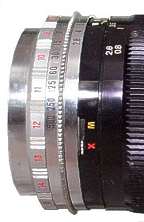 The outer ring is numbered to coincide with the numbers on the Exposure Meter dial. Yashica's tried and true split image range-finder, self corrects for parallax. Manual focus is capable from 2.6 ft [0.8 meters] to Infinity, with clear graduations, in case it ever gets too dark to use the range-finder. The specific camera we are looking through, even as we write, has no problem focusing on distant areas of the room which are too dark to comfortably read a newspaper by. Try that with your SLR ! The independent built in exposure meter can be set within a range of ASA 10 to 400. There is no DIN scale. The exposure meter runs off a 625A battery, inexpensive and readily available, but not required to use the camera. The lack of a Hot Shoe is probably a plus, as this encourages the use of a hand grip / flash holder combo, the only way to get both a secure grip on such a small instrument and freedom from dreaded "red eye". A PC socket is mounted on the front left, and as with all front located photo flash connectors, care should be taken to make sure that the cable cannot dangle in front of the lens. A button with a red dot, located at the rear, extreme top left of the camera, activates the exposure meter. A plastic stud about halfway across the top rear, is just a dummy plug, for what may have been intended as a battery check during the design stage. This is common to several Yashica models. The loading door is opened by sliding a small lever on the left side of the base from "P" to "O", and while in the "O" position, pressing inward. It takes a little practice to get used to this. The tripod mount socket is secured to the frame of the camera by 4 screws on a mount beneath the cover plate. The thread stops short of bottom leaving enough space to work a wire tie under, and can be clearly seen through the hole as it makes it's way. What this means is that a portal exists for all sorts of contaminants to enter into the inner workings of the camera. We store our camera with a ¼ X 20 set screw inserted. Keeping the camera in a case would solve that, but of course you know that "carrying" cases are for just that purpose. Never store a camera, collectors knife or gun in a case, most particularly in a warm climate with salt air, but then everyone knows that, or do they? A small number of these cameras were produced under the marque, Minister 700 with an ƒ 1.7 lens. The only 700's that I have ever seen on offer were in the UK.
The outer ring is numbered to coincide with the numbers on the Exposure Meter dial. Yashica's tried and true split image range-finder, self corrects for parallax. Manual focus is capable from 2.6 ft [0.8 meters] to Infinity, with clear graduations, in case it ever gets too dark to use the range-finder. The specific camera we are looking through, even as we write, has no problem focusing on distant areas of the room which are too dark to comfortably read a newspaper by. Try that with your SLR ! The independent built in exposure meter can be set within a range of ASA 10 to 400. There is no DIN scale. The exposure meter runs off a 625A battery, inexpensive and readily available, but not required to use the camera. The lack of a Hot Shoe is probably a plus, as this encourages the use of a hand grip / flash holder combo, the only way to get both a secure grip on such a small instrument and freedom from dreaded "red eye". A PC socket is mounted on the front left, and as with all front located photo flash connectors, care should be taken to make sure that the cable cannot dangle in front of the lens. A button with a red dot, located at the rear, extreme top left of the camera, activates the exposure meter. A plastic stud about halfway across the top rear, is just a dummy plug, for what may have been intended as a battery check during the design stage. This is common to several Yashica models. The loading door is opened by sliding a small lever on the left side of the base from "P" to "O", and while in the "O" position, pressing inward. It takes a little practice to get used to this. The tripod mount socket is secured to the frame of the camera by 4 screws on a mount beneath the cover plate. The thread stops short of bottom leaving enough space to work a wire tie under, and can be clearly seen through the hole as it makes it's way. What this means is that a portal exists for all sorts of contaminants to enter into the inner workings of the camera. We store our camera with a ¼ X 20 set screw inserted. Keeping the camera in a case would solve that, but of course you know that "carrying" cases are for just that purpose. Never store a camera, collectors knife or gun in a case, most particularly in a warm climate with salt air, but then everyone knows that, or do they? A small number of these cameras were produced under the marque, Minister 700 with an ƒ 1.7 lens. The only 700's that I have ever seen on offer were in the UK.

The Yashica Electronic Eye [model EE] was introduced as near as can be estimated between late 1962 and early 1963. The ƒ1.9 lens version in my collection was sold for ¥18,800. A ƒ2.8 version hit the street at about the same time, and likely sold for ¥1350 or so, going by past model pricing differences.
The EE is a full sized and fully featured camera with a built in exposure meter powered by a selenium photo cell that surrounds the lens. It differs substantially from the Minimatic of that year in that the EE is totally user controlled. The Copal SVA shutter has settings through 500th sec, 250, 125, 60, 30 15, 8, 4, 2, 1, and Bulb. X or M flash sync can be set. A self timer lever is mounted at the bottom of the lens barrel, but I would not suggest trying to use it unless the camera has been recently lubricated, as it could jam the works.
The Aperture ranges from ƒ1.9 down to ƒ16. The selected setting is viewed through a window on the lens barrel. Film speed can be set for ASA / ISO only. DIN is as dead as the Dodo and not even a conversion chart can be found in the door. The scale is from ASA 10 to 800, so the camera is ready for just about any task that you can throw at it, within the limitation of the short focal length 4.5cm fixed lens.
The frame counter ring is serrated and is expected to be set, by rotating it with a fingernail clockwise to the "start" position, indicated by a red diamond. A simple and trouble free system. A PC flash socket is mounted on the end side below the rewind crank. There is no "Hot Shoe". The shutter release is threaded to accept an industry standard cable release.
The only odd feature is, the tiny peephole above the fixed frame viewfinder, through which, if the planets are correctly aligned, one can see the exposure meter needle. Eyeglass wearers need not apply.The loading door is opened by pushing in a pin on the bottome plate and swinging to the "O" position. There are several illustrations of this elswhere on this page. If you can get over the look of the bug-eye fresnel lens surrounding the optics, this camera is really very appealing, what with not even needing a battery, and it is heavy enough to hold steady. The light and dust seals are still as new.
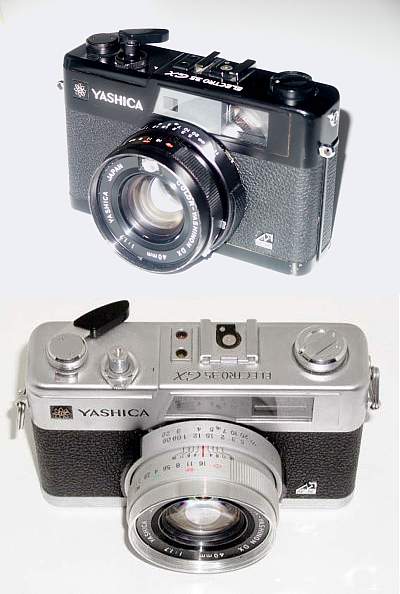
The GX was introduced in 1975. The AF [Auto Flash] logo is clearly visible on the lower front right and the required third contact can be seen on the Hot Shoe. A PC socket is mounted on the right upper side.
The Pro black finish version shown here is not often encountered. The ƒ1.7 40mm Yashinon Lens consists of 6 elements in 4 groups, and accepts 52mm screw-in accessories. Unlike the Yashica FC, this camera does support Fill Flash.
Third party non dedicated strobe flash units will fire when plugged into the PC socket, but not when mounted only on the hot shoe.
I can strongly recommend the Yashica PRO 50 DX flash for use with this camera. The 50 has a PC socket cable needed for this camera and also has the ability to charge the flash with a removeable AC adapter, most useful to re-fresh the capacitor even if you plan to use it with batteries. These show up from time to time on auction.
The Yashica dedicated flash required may be extremely hard to find.
The system employs a Silicon photo cell in place of the CDS found in the G Electro series. This shot of the black GX is shown with thanks to Joep Clason of the Netherlands.
The chrome satin version makes it possible to see the detail a little better. This image was kindly made available by Saul Frank of CESCO in Australia.
This camera was intended to use two PX640 batteries that are no longer available.
For a complete description of the GX, please refer to the printer friendly English text only manual that is available here. It contains a considerable amount of useful information not readily found elsewhere that will be of interest to beginning photographers regardless of which camera they use.
Just Click Here to view or print the GX Manual
To return here use your Browser 'Back' button.
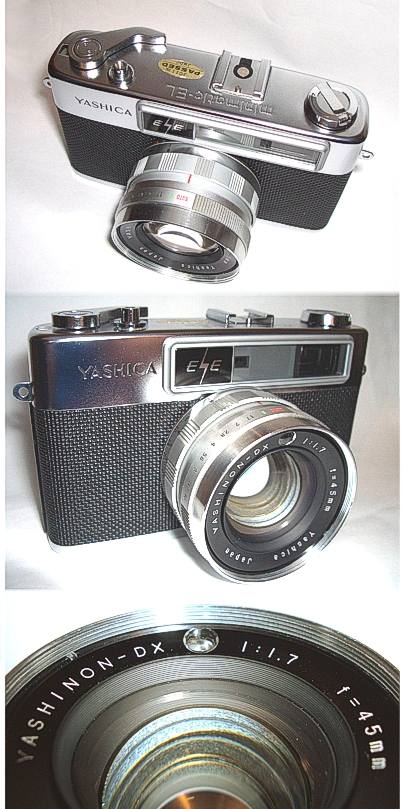 The Minimatic EL
The Minimatic EL
The Minimatic EL introduced in 1967, is a true split image rangefinder. As described by Werner J Becker of Germany, who kindly supplied the images, the camera appears very similar to the Lynx 14, as does it's film chamber. Being a fully automatic EE camera, there is no exposure indicator visible in the finder or elsewhere on the body other than the Red signal that appears in the upper finder view in the event of overexposure. In this case an exposure can not be made. A neutral density filter needs to be attached, and because the light sensor is in the lens cluster, the required exposure correction is added into the calculation, and hopefully shooting can resume.
A closeup of the sensor can be seen in the third image of the group shown to the left.
The Yashica Minimatic shown is fitted with a Yashinon DX lens with an aperture of ƒ1.7 and has a 45mm focal length. The twin leaf Copal shutter seems to have a range of between 1/30 and 1/500th sec. Like most Yashica offerings, one can expect that this camera may have been supplied with a ƒ2.8 lens in a budget version, although we have yet to spot one of these.
Use in The Electronic Exposure auto mode [EE] requires a PX625 battery. The camera will draw current unless the lens cap is in place. If the camera will not be used for a while, it is prudent to remove the battery. In the B position the aperture is wide open. In the Flash setting, the aperture can be manually set from ƒ1.7 to ƒ16 as determined by the Guide Number of the Strobe Flash.
The film speed setting has a range of from 12 to 400 ASA, so it can easily accommodate any current film one is likely to use. As in the latest Yashica GSN, the ASA speed is regulated by a variable iris in front of the light sensor.
Werner comments that this lens is a real performer, which is supported by the considerable feedback that we have received on the Yashinon DX optics.
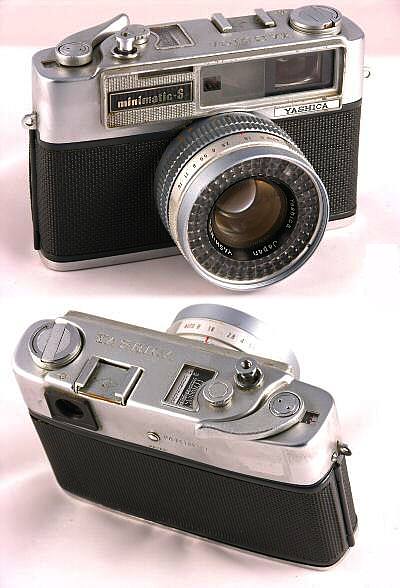
The Minimatic-S
This camera has clean cut lines and a more convenient exposure indicator. Other than that, it is as I see it, an upgrade to the Minister III. A self powered selenium photocell means you never need to worry about a battery. All you need is film and you are set to roll.
The images were kindly provided by Al Rindfleisch, USA.
It also differs from the Minister III in that the Citizen shutter has been replaced with a Copal shutter with self timer and is fitted with a 45mm Yashinon lens with an aperture range of ƒ1.8 to ƒ16. The shutter release is threaded to accept a standard extension release cable. As best as we can track it, the camera made it's first appearance in Japan in 1963.
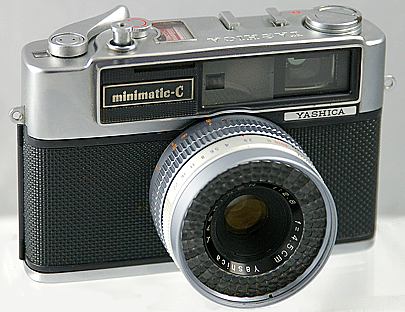 The Minimatic C version is quite similar and was released in1963 with a different lens and dressed up with red color highlights ringing some controls and on the exposure and focal plane indicator.
The Minimatic C version is quite similar and was released in1963 with a different lens and dressed up with red color highlights ringing some controls and on the exposure and focal plane indicator.
The image and specs were kindly provided by Tom Borrino, USA. This version has an ƒ2.8 lens with a 45mm focal length. Seldom seen in cameras these days is the ability to stop down all the way to ƒ22, allowing for incredible depth of field. The shutter is a Copal Unique with a simple and reliable two blade shutter, the speed of which is selected by the camera. The shutter can be set to "B" for time exposures and full AUTO marked in red. The ASA speeds range is 10, 16, 25, 32, 40, 50, 100, 160, 200 and 400 in white numbers on a red background, and in DIN 11, 13, 15, 16, 17, 18, 21, 23, 24 and 27 using red numbers on a white background. If you are wondering about those low numbers, that is what we had to struggle with if we wanted to use the early colour films. Note the PC socket for flash is located on the side below the rewind crank that helps to keep the cable out of the way of the lens. The frame outline is fixed.
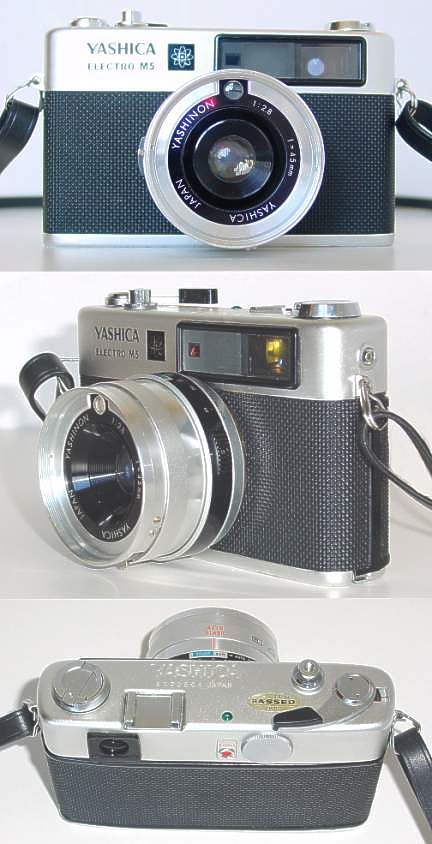
The long awaited M5 has arrived. Let me describe it as best I can. Oh!..... the best news is it works on a 544 battery out of my RTS and FR!!!! [not to mention the CC, CCN, MC, and many other cameras so the battery should continue in production for the foreseeable future.]
At first it didn't work, and I played around researching batteries until I simply couldn't figure it out then said "Horses Nancy not Zebras" and ran a bit of steel wool over the contacts despite their appearing whistle clean and Voilà it ran.
The camera measures approx the same height and depth of the electro 35, but is perhaps 5 mm smaller side to side. It feels very much lighter than the 35. The top looks similar with a rewind handle secured with a screw not rivet, and the back door opens with the little tiny latch on the bottom plate not with the rewind lever. [ This can be clearly seen at the bottom right in the second image ] Cold shoe with no markings -- PC cord socket is on left like 35. The shutter button has no lock and has a shorter throw than the 35 although it feels the same, slack, on top and engages at the bottom.
The winder lever is smaller than the 35. There is no electro 35 "clunk". (Oh my, I just noticed the counter actually works!) Same spot as Electro, and similar appearance. The top is stamped Yashica with numbers and Japan below. No bottom plate markings.
The lens barrel:
ASA is set underneath the barrel with a little lever 25-500. The focus ring is black plastic with usual electro marking. There is a self timer like the electro but on the right side of barrel (and it works!) Now the weird part to me; no f stops... three pictures the same as on the Electro:......the sun, cloud, and window and to the left a spot marked in red "autoflash"
It looks like the sun one opens to a size half as large as the f16 stop on my
Zeiss 50mm lens. Could it be about f22 allowing for the 45mm focal length of this one?. The cloud looks about the size of f8 and the window about the size of a 2.8 . (I am no expert on cameras, just an interested amateur so these are my best guesses) There is no in-between, I tried it. The shutter meters it's 'open time' according to ambient light but gives no indication of over under, etc.
Best open time on "sun" in a very darkened room seemed about 10 seconds. My electro will stay open on bulb for at least 30 seconds, can't remember the specs but took some of my best pix on a tripod with long auto exposures. Just can't tell in the house how fast it is wide open but seems pretty fast. My guess 125 in the house so I'll bet 250 to 500 outside. (Without a battery this camera is totally dead, I thought I had an interesting but costly DOA initially)
The only other marking is the word "Citizen" [ of wrist watch fame ] stamped on the outer ring near the ASA in the same manner that COPAL ELECT is on the electro. It looks like the shutter leaves open to expose another leaf with the appropriate size hole in it. They do not "create" the aperture themselves. The leaves open in a lozenge shape large enough to expose the "hole" in the bottom leaf plus a little. It seems as though, if rotating the barrel only chooses one of the three pre-stamped apertures in an under leaf. The outer leaves? shutter? actually meter the exposure time? That is what it looks like anyway.
It has the older type leatherette and instead of a sideways diamond split screen spot has a rectangle. I can see the parallax correction working when I focus. The back seals are deteriorated but very dry, not sticky like most oldies are. It even came with an older style case in pretty good shape. Could Yashica have "pinched" the M5 designation as a sound alike for the Leica M5? One way to tell is if the Yashi M5 preceded the intro of the Leica M5 in 1971, which seems most likely. Does anyone have any dates?
Note re: the M5. Dave Guthrie of Canada has emailed along a scan of page 18 of the manual confirming the aperture settings for the exposure symbols above as estimated by Nancy Owens are correct.
The Yashica Electro FC [Flash Camera] was introduced in 1973. It bears an uncanny resemblance to the Canon QL19 shown in the inset, and if you saw them in use side by side you might well wonder which twin had the Toni. Needless to say, any similarity between these two cameras ends right there.
uncanny resemblance to the Canon QL19 shown in the inset, and if you saw them in use side by side you might well wonder which twin had the Toni. Needless to say, any similarity between these two cameras ends right there.
We are indebted to Joe Kraus of Australia for providing the © Images of the chrome FC.The images of the black Pro finish FC were submitted by Marco Pastori of Italy. This illustrates again that without the co-operation of the world camera community, this site would really not be possible.
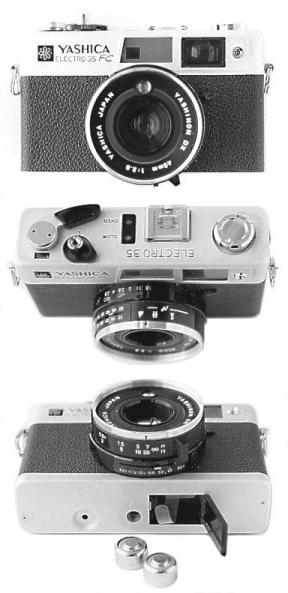
The FC incorporates both the time tested Magic Dot split image rangefinder and Electro stepless shutter exposure system. Both these features are previously detailed. The ASA speed can be matched to virtually any current film. Settings are at 25 50 100 200 400 800 ASA. When the camera is set in the FLASH mode, the ASA setting will determine the aperture for the flash output of a specific Yashica dedicated strobe, like the model ES-20.
The setting for flash is quite specific and the camera appears to have been put into production based solely on tests conducted within the Yashica facility.
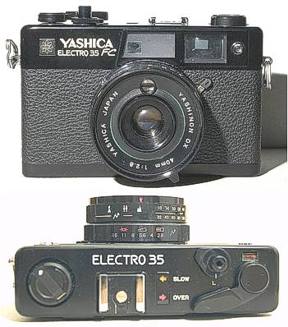
A field trail would have immediately revealed the design failure which prevents the use of flash at other than the 1/30 sec exposure setting.
This of course prevents the use of fill flash in daylight, a feature almost all the other Yashica rangefinders support, the other noteable exception being the model CC.
The 40mm DX Yashinon ƒ2.8 lens will serve you well in tight quarters as well increasing the depth of focus to some extent as compared to a "normal" 50mm lens.As with the CC and MG-1 models, the light sensor is mounted within the lens assembly so no manual compensation of ASA settings are required when using filters. Battery power is required to operate the shutter at any other than the fall back speed of 1/500 sec. This is provided by two PX640A batteries, unfortunately discontinued by Duracell in January 2000.
We are fortunate that the "Suits" of the time at Yashica were blessed with good humour and chose to run this advertisement in time for Haloween 1969, a series shown in September, October and December of that year. This material was kindly made available to us by Ake Lindfors of Angelholm, Sweden.


We would like to hear your take on this site Send us an eMail ! via this link